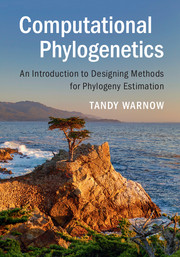Book contents
- Frontmatter
- Dedication
- Contents
- Preface
- Glossary
- Notation
- PART I BASIC TECHNIQUES
- 1 Brief Introduction to Phylogenetic Estimation
- 2 Trees
- 3 Constructing Trees from True Subtrees
- 4 Constructing Trees from Qualitative Characters
- 5 Distance-based Tree Estimation Methods
- 6 Consensus and Agreement Trees
- 7 Supertrees
- PART II MOLECULAR PHYLOGENETICS
- Appendix A Primer on Biological Data and Evolution
- Appendix B Algorithm Design and Analysis
- Appendix C Guidelines forWriting Papers About Computational Methods
- Appendix D Projects
- References
- Index
4 - Constructing Trees from Qualitative Characters
from PART I - BASIC TECHNIQUES
Published online by Cambridge University Press: 26 October 2017
- Frontmatter
- Dedication
- Contents
- Preface
- Glossary
- Notation
- PART I BASIC TECHNIQUES
- 1 Brief Introduction to Phylogenetic Estimation
- 2 Trees
- 3 Constructing Trees from True Subtrees
- 4 Constructing Trees from Qualitative Characters
- 5 Distance-based Tree Estimation Methods
- 6 Consensus and Agreement Trees
- 7 Supertrees
- PART II MOLECULAR PHYLOGENETICS
- Appendix A Primer on Biological Data and Evolution
- Appendix B Algorithm Design and Analysis
- Appendix C Guidelines forWriting Papers About Computational Methods
- Appendix D Projects
- References
- Index
Summary
Introduction
In essence, there is really one primary type of data used to construct trees – characters. An example of a character is the nucleotide (A, C, T, or G) that appears in a particular location within a gene, the number of legs (any positive integer), or whether the organism has hair (a Boolean variable). In each of these cases, a character divides the input set into disjoint subsets so that the elements of each subset (which could be molecular sequences or biological species) are equivalent with respect to that character. We will refer to the different sets defined by the character as the character states. In other words, a character is an equivalence relation on the set S of taxa, and the different equivalence classes are the different character states. However, characters can also be described by functions from the taxon set S to the set of character states.
The number of states the character can take is an important aspect for modeling purposes. Many characters are based on sites within a molecular sequence alignment, and thus have a maximum number of possible states (four for DNA or RNA, and 20 for amino acids). Morphological features can be multi-state (and perhaps even have an unbounded number of possible states), but many morphological features are just based on the presence or absence of a given characteristic, and hence are explicitly binary.
Most stochastic models assume that the taxa are related by a tree, and that a character evolves down the tree under a process that involves substitutions. However, not all evolution is treelike; for example, horizontal gene transfer (HGT) is common in some organisms (e.g., bacteria) and hybridization (whereby two species come together to make a new species) is also frequent for some organisms (e.g., plants).
Character-based methods are the basis of nearly all phylogenetic estimation methods, since characters form the way the input is nearly always described. If the evolutionary process operating on the characters can be modeled adequately, then phylogeny estimation – whether of a tree or of a phylogenetic network – can be performed using statistical methods, such as maximum likelihood or Bayesian MCMC. However, when no statistical model is available (or the statistical models are unreliable), then simple methods that are not based on explicit models of evolution can be used to estimate trees.
- Type
- Chapter
- Information
- Computational PhylogeneticsAn Introduction to Designing Methods for Phylogeny Estimation, pp. 61 - 82Publisher: Cambridge University PressPrint publication year: 2017



